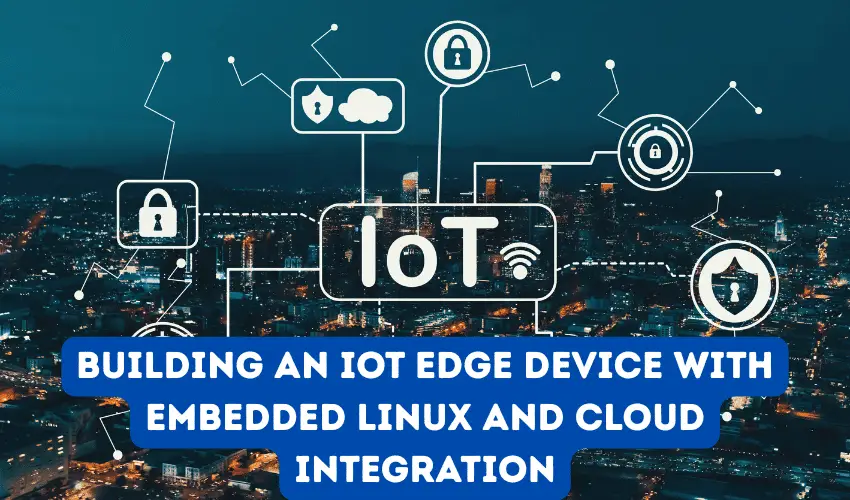Due to the rise of sensors, smart machines, and instant decisions, IoT edge devices are taking on the main roles in digital transformation. They serve as smart gateways, getting data from the world around them, processing it locally, and sending important information to the cloud in a safe way. Many of these solutions rely on Embedded Linux, which is picked for being flexible, scalable, open-source, and easy to maintain over the long term.
The use of connected embedded systems is increasing rapidly whether you are measuring temperature in farming, charging electric vehicles, or streaming data from medical devices. Still, it takes various elements to create such a system: hardware, choosing an OS, secure networking, data communication methods, cloud APIs, and ways to update the system.
In this article, we’ll walk through the entire journey of creating an IoT edge device powered by Embedded Linux - from hardware selection to cloud integration and real-world deployment. With insights from our own experience at Embrox, including complex industrial use cases, you’ll learn how to architect and implement robust edge devices that scale.
Choosing the Right Hardware
The foundation of an edge device is its hardware. Common choices include Raspberry Pi, BeagleBone, STM32MP1, or fully custom boards. Make selections based on:
- CPU power and memory requirements
- Connectivity needs - Wi-Fi, Ethernet, LoRa, etc.
- Power constraints and operating environment
- Peripheral support, including I²C/SPI and GPIO
For this tutorial, we’ll use a Raspberry Pi 4-like platform - flexible, well-supported, and capable of running full Linux distributions.
Installing and Configuring Embedded Linux
Once hardware is ready, choose an appropriate Linux distribution:
- Buildroot or Yocto for a highly-customized, minimal system
- Raspberry Pi OS (Debian-based) for simplicity and community support
After flashing the OS to the SD card or eMMC, perform initial setup:
- Enable SSH and configure network settings
- Create custom Linux users and disable default credentials
- Set up systemd units for your core IoT service
- Harden the system - disable unused services and configure firewalls
This ensures a secure, resilient system on which your IoT software will run reliably.
Sensor Integration and Data Acquisition
The core of an IoT edge device is its ability to interact with the physical environment. To integrate a sensor:
- Connect via I²C, SPI, or GPIO interfaces
- Use C or Python libraries to read raw data
- Wrap sensor readings into structured JSON payloads
Example in Python:

This forms the basis for sending clean, actionable data to the cloud.
Cloud Integration Architecture
Connecting your device to the cloud involves these layers:
- Device: embedded Linux running sensor-reader
- Transport: MQTT or HTTPS with TLS
- Broker/Cloud: such as AWS IoT Core, Azure IoT Hub, or a custom broker (e.g., Eclipse Mosquitto)
- Backend and Dashboard: databases, analytics, and dashboards
The architecture typically flows:
We'll illustrate using Mosquitto as a broker, forwarding data into cloud-hosted databases and dashboards.
Sending Data to the Cloud
Communicating securely is essential. Here’s a Python example using paho-mqtt:
Ensure you:
- Use TLS for encryption
- Validate broker certificates
- Implement retry and buffering logic for offline scenarios
Security Considerations
Securing IoT devices involves multiple layers:
- Transport: TLS 1.2+ for MQTT/HTTPS
- Identity: Unique device certificates or secure tokens
- Boot and Filesystem: Secure boot, read-only partitions
- Network: Firewall off unnecessary ports; use VPNs if needed
Device authentication and image signing - especially with A/B or rollback-safe partitioning - enhance reliability and security.
Monitoring and Remote Management
Once devices are in the field, managing them remotely becomes critical.
Common practices include:
- Collecting logs via syslog, journald, or local dashboards
- Implementing OTA updates using tools like Mender, Balena, or custom scripts
- Maintaining device health using heartbeat messages and remote shell access
With this in place, fleets of devices can be managed and updated efficiently.
Real-World Use Case: IP Telephony Edge Device
A compelling example of embedded Linux at work is Embrox’s development of an IP telephony edge device. In this project, Embrox:
- Built an embedded Linux system optimized for real-time audio over IP
- Developed custom drivers and optimized network stacks for low latency
- Integrated audio codecs using C++ and QT for administrative oversight
- Ensured secure, ongoing updates via automated CI/CD and certificate rotation
This solution bridged hardware and software, demonstrating Embrox’s capability in delivering robust enterprise-grade edge systems. By integrating mechanical acoustics, embedded drivers, and Linux security, the system achieved reliable VoIP performance across varied environments - showcasing the company’s full-cycle embedded expertise.
Conclusion
This guide covers the core steps of building a secure, reliable IoT edge device with embedded Linux and cloud integration. From hardware selection to sensor interfaces, secure cloud communication, remote management, and OTA updates - it emphasizes both the theory and practical implementation.
By extending this framework, teams can scale to device fleets, introduce enhanced analytics, and adopt modern containerized workflows using Docker or Balena.
We are giving you exclusive deals to try Linux Servers for free with 100$ credit, check these links to claim your 100$,
DigitalOcean - 100$ free credit & Linode - 100$ free credit
Check some Exclusive Deals, HERE.
Also, check out DevOps Book You should read section.
